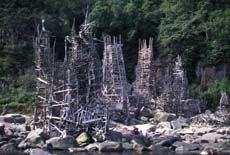index
Kant on judgment and grammars
click on images for full-size:




Determinative judgment: This is a building

Reflective judgment: This is a . . .

Establishing selves, norms, concepts, objects, all together
In the introduction to his Critique of Judgment (Kant1987), Kant discusses the act by which knowers relate concepts to particular cases. He distinguishes two kinds of judgment. In the first we classify items under already given concepts. We examine an animal and say it is a horse. We experience the place and classify it as a shopping center. In this kind of judgment, the concepts and criteria are already available to be applied. In the other kind of judgment we must construct a new concept. Faced with a new kind of art work or a new kind of social movement, we construct a concept and some criteria for talking about it. We define and relate it to other items. In so doing we describe or reveal the items either for the first time or in new ways. This second kind of judgment, which Kant calls reflective judgment, creates a new concept, or more likely a new set of concepts. This is a set of norms and criteria that recognize and reveal a new field of possibilities. A concept of a new kind of artwork creates new criteria for making distinctions. Then other new kinds of artworks get suggested by variation on the new concepts. Also, the relations among previous kinds of art works change as they are seen in new contrasts and relations.This reflective judgment, then, looks very much like what I have been calling the process of setting up a social grammar. Neither the universal concept nor the particular item is fully given in advance. The process reveals and determines them. The norms and the things normed emerge together.
- [Return to "connections/oppositions"]
- [Nearby: Kant outline -- Hegel on mediation -- Kant's argument for linkage ]